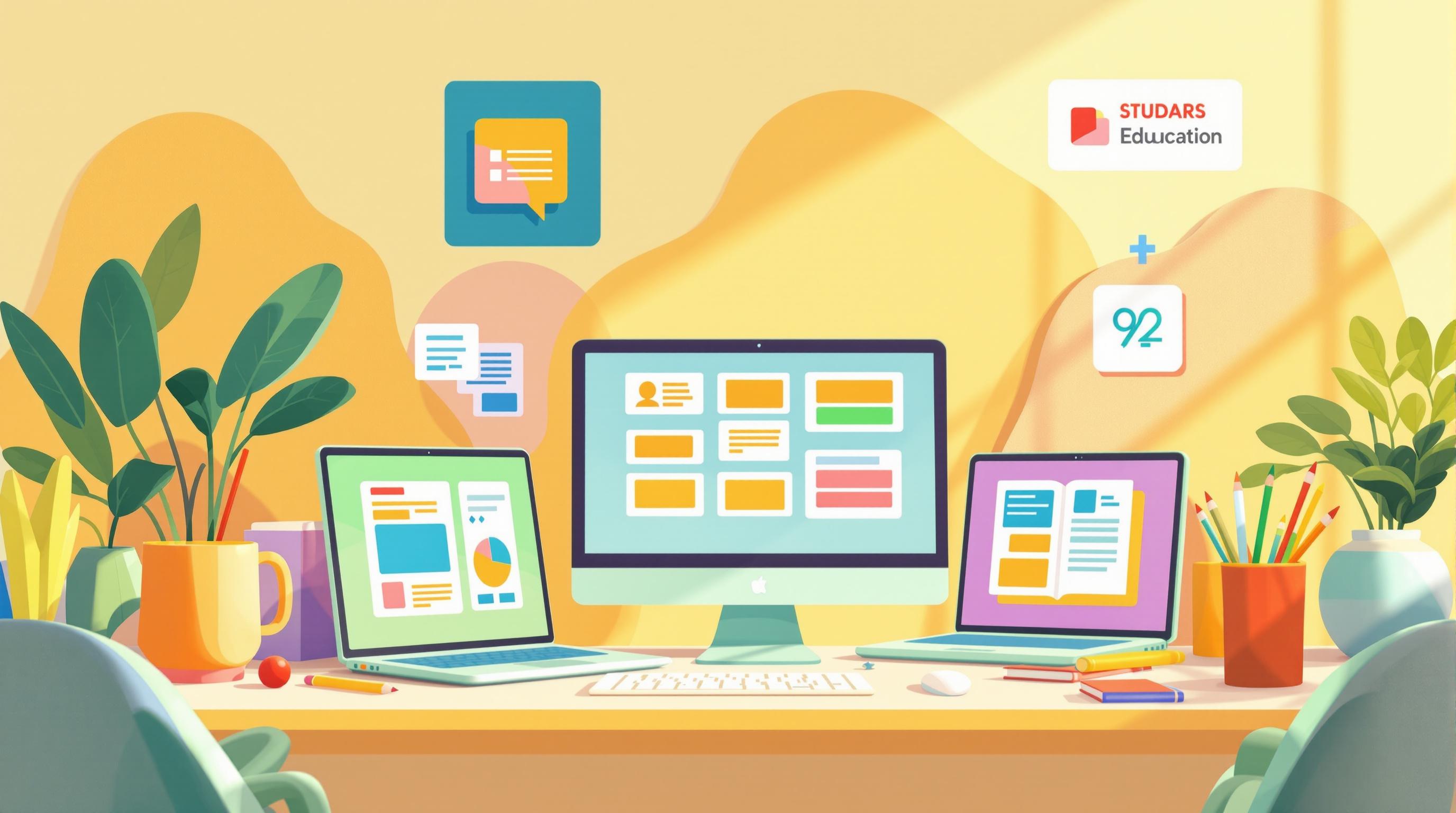Managing student behavior can be exceptionally challenging for special education teachers.
However, with research-backed strategies and a proactive plan, you can create a positive classroom environment where all students can thrive.
In this post, we'll explore practical techniques for assessing behaviors, setting clear expectations, designing an engaging classroom, and refining interventions to successfully manage special education behaviors.
Introduction to Managing Behavior in Special Education
Special education classrooms can present unique behavioral challenges. Students with disabilities often exhibit problems like noncompliance, disruptiveness, aggression, or self-injury. Without proper management, these behaviors can severely impact learning. This section provides an overview of common special education behavioral issues and the importance of implementing effective strategies.
Understanding Behaviors in Special Education
Students in special education frequently demonstrate challenging behaviors related to their disabilities. For example:
- Noncompliance: Refusing to follow directions, passivity, or failure to respond.
- Disruptiveness: Yelling, tantrums, constant noisemaking that interrupts instruction.
- Aggression: Hitting, kicking, throwing objects, verbal threats, etc.
- Self-injury: Head banging, skin picking, hand biting, or other self-harming actions.
It's critical to understand these behaviors often communicate an underlying need. Determining the function through assessment can inform strategies.
The Ripple Effect of a Special Needs Child Disrupting Class
When inappropriate behaviors occur, they can significantly disturb learning, lower class wide self-esteem, and reduce instructional time. For example, aggressive episodes may trigger peers' flight-or-fight response, making concentration difficult. Or students may internalize beliefs that misbehavior reflects poorly on them.
Unmanaged behaviors also have long-term impacts like poor academic outcomes or negative school sentiments. Implementing consistent strategies is essential.
Establishing Goals for Positive Classroom Management
Effective classroom management aims to:
- Provide needed structure through schedules, clear expectations, etc.
- Meet unique student needs by adapting the environment, accommodating disabilities.
- Actively teach and reinforce positive replacement behaviors.
- Foster student independence and self-regulation skills.
With consistency and effort, special education teachers can create safe, productive environments where all students succeed.
How do you manage behavior in a special education classroom?
Managing behavior in a special education classroom requires a multifaceted approach that includes:
Clear Expectations and Rules
- Set 3-5 clear, concise rules for behavior. For example: Follow directions, keep hands and feet to self, use respectful language.
- Post rules visibly around the classroom and review them regularly.
Consistent Routines
- Establish routines for transitions, activities, and downtime. Consistency and structure is calming for many students.
- Use picture schedules, timers, visual cues and warnings before transitions. Give reminders of expectations.
Positive Reinforcement
- Catch students following expectations and reinforce the positive behaviors verbally and with rewards like stickers or points towards a fun activity. This encourages good behavior.
De-escalation Strategies
- Stay calm, use even tone, validate feelings. This prevents worsening behaviors during emotional escalations. Redirect to preferred activity if needed.
Collaboration with Support Staff
- Work with paraprofessionals, therapists, behavioral specialists and parents. Get training on specific behavior plans. Consistent implementation across staff is key.
The most effective special education classrooms balance clear structure and expectations with empathy, patience and teamwork to manage behaviors positively. Consistency, proactiveness and understanding emotional triggers helps minimize disruptions.
What techniques will you use to successfully manage classroom behavior?
Managing student behavior can be challenging for special education teachers. Here are some effective techniques:
Use a structured environment. Special needs students, particularly those with autism or emotional disturbances, thrive on routines and consistency. Set clear expectations, post visual schedules, and reinforce rules regularly.
Reinforce positive behaviors. Catch students being good and praise them. Use incentive programs to motivate students. Positive reinforcement is more effective than punishment in building good habits.
Address behavior issues early. When you see a problem emerging, intervene right away. Don't allow small issues to escalate. Use redirection, proximity control, or planned ignoring. Call home and get parents on board.
Build strong relationships. Get to know your students and let them know you care. An encouraging teacher-student bond promotes cooperation and compliance. Make time for one-on-one interactions.
Collaborate with staff. Work closely with aides, therapists, and caregivers to implement behavior plans consistently. Share observations and insights to develop effective strategies tailored to each student's needs.
With structure, encouragement, consistency and teamwork, you can make real strides in helping special needs students successfully regulate their behavior.
What strategies do you use to manage student's behavior in your classroom?
Managing student behavior in special education classrooms can be challenging, but implementing some key strategies can help. Here are 3 effective techniques to try:
Set clear expectations and rules
- Involve students when creating classroom rules. This builds ownership.
- Display rules clearly. Review them regularly.
- Frame rules positively - what TO do rather than what NOT to do.
Use positive reinforcement
- Praise good behavior often, especially when students are still learning desired behaviors.
- Consider a token reward system for meeting expectations.
- Give them responsibility and leadership roles to motivate good conduct.
Deescalate issues calmly
- Speak privately to disruptive students. Understand reasons behind their behavior.
- Allow short breaks for students to regain self-control.
- Keep responses measured. Overreacting often escalates unwanted behaviors.
Consistently applying these methods can minimize incidents over time. Remember to adjust approaches based on each student's unique needs. With patience and compassion, you can cultivate a safe, thriving environment for special education learners.
How do you deal with disruptive behavior in special education?
Dealing with disruptive behavior in a special education classroom can be challenging. Here are some effective strategies:
- Set clear expectations and rules. At the start of the year, collaboratively create classroom rules with students. Visual rules can help students remember. Praise students when they follow them.
- Build relationships. Get to know each student, their triggers, interests, etc. A strong bond makes redirecting behavior easier.
- Use positive reinforcement. Compliment students when they demonstrate good behavior. Consider using a reward system. This encourages continuity.
- Remain calm and patient. Students with behavioral disorders often act out when escalated. Keep a neutral, understanding tone to de-escalate situations.
- Modifications and accommodations. Adjust lessons and activities to suit disabilities causing acting out. Accommodations relieve stressors.
- Work with support staff. Collaborate with other staff to create Behavior Intervention Plans for recurrent issues. Consistency across staff is key.
Staying patient and consistent with these strategies will lead to a well-managed environment where all students can learn. Let me know if you have any other questions!
sbb-itb-bb2be89
Crafting a Special Education Classroom Management Plan
Managing student behavior can be challenging in any classroom, but special education environments bring added complexity. An effective special education classroom management plan accounts for students' unique needs while establishing structure through clear expectations.
Conducting Behavioral Assessments
Before intervening, teachers must understand the function or purpose behind concerning behaviors. Strategies include:
- ABC Analysis: Document the Antecedent, Behavior itself, and the Consequence to identify patterns.
- Scatterplots: Track frequency and timing of behaviors throughout the day/week.
- Functional Behavior Assessments: Interview students, parents, other teachers to hypothesize the function of behaviors.
Assessments inform individualized behavior intervention plans for IEPs.
Building Expectations: Classroom Rules for Special Needs Students
Realistic rules set students up for success. Consider:
- Visual rules: Post pictorial representations of 3-5 positive rules.
- Social narratives: Explain policies regarding asking for breaks, calming strategies.
- Regular review: Revisit rules briefly each morning.
- Positive framing: Use do language (walk inside) not don'ts.
Involve students when establishing guidelines. Adjust as needed.
Designing a Classroom Environment for Special Needs Students
Proactive planning prevents problems by accommodating needs:
- Organization: Label centers and materials. Reduce clutter.
- Flexible seating: Rockers, cushions, standing desks allow movement.
- Divide space: Provide calm-down corners and quiet reading nooks.
- Sensory tools: Fidgets, headphones, therabands offer outlets.
Change environments to prompt positive conduct.
Engaging and Adaptive Instruction Strategies
Curriculum tailored to learning levels boosts comprehension and minimizes acting out.
- Differentiate content: Individualize difficulty, materials.
- Multimodal methods: Incorporate visual, auditory, tactile options.
- Movement breaks: Brain breaks prevent restlessness.
- Choices: Increase autonomy through assignment/activity options.
Accommodating diverse needs encourages motivation and self-regulation.
Ongoing data collection and refinement keeps plans effective as students grow. With understanding and supports, special educators transform behaviors, unlock potential, and promote inclusion.
Behavior Management Strategies in Action
Managing student behavior can be one of the most challenging aspects of teaching special education. When behavioral issues arise in an inclusive or self-contained special education classroom, it is essential that teachers have evidence-based strategies ready to implement.
Leveraging Positive Reinforcement
Using positive reinforcement is a cornerstone of effective special education classroom management. When students with disabilities exhibit appropriate behavior, teachers should provide descriptive praise and meaningful rewards. For example:
- Praise: "Great job raising your hand and waiting patiently for me to call on you, Jose!"
- Rewards: Allowing 5 extra minutes of preferred activity time, providing sticker charts, offering food reinforcers, etc.
Targeting 3-5 positive behaviors to reinforce per student can yield significant improvements over time.
Behavioral Shaping Techniques for Skill Acquisition
For behaviors a student is lacking, techniques like modeling, prompting, scaffolding and chaining can teach missing skills. For instance:
- Model the desired behavior, like walking quietly in the hallway
- Prompt the student before the behavior is required
- Scaffold more support initially, fading prompts over time
- Chain behaviors, reinforcing each step
Using these methods systematically shapes positive behavior.
Selective Attention: Managing Minor Disruptions
Ignoring attention-seeking or tangential minor misbehaviors is often effective. For example, briefly looking away, not responding verbally and withholding reinforcement when a student makes silly noises can reduce the behavior over time. This selective attention strategy allows teachers to focus on instruction.
Applying Time-Out for Serious Behavior Issues
If a student exhibits aggression, elopement, property destruction or major disruption, temporarily removing them from the situation may be required. For example:
- Have student spend 5 minutes away from positive reinforcers or preferred activities
- Make sure to debrief behavior afterward and reinforce for compliance
- If time-out locations don't work, physical restraint may rarely be needed to ensure safety
Having emergency procedures ready for severe behaviors is key.
With consistent implementation, evidence-based strategies like these can significantly improve classroom climate and learning outcomes. The central theme is reinforcing positive behaviors systematically while reducing reinforcement of negative behaviors.
Adjusting Classroom Management in Inclusive Education
Managing behavior in an inclusive classroom presents unique challenges, as students have a range of learning needs. Teachers must be responsive and continuously refine their approaches. Here are some strategies for assessing impact and modifying plans:
Gathering and Utilizing Behavioral Data
- Record frequency, intensity, duration, and triggers of behaviors. Apps like Behavior Snap can track this data.
- Take ABC (antecedent, behavior, consequence) notes to identify relationships.
- Have students self-monitor behaviors via checklists or reflections.
- Survey students on their emotional states and what helps them self-regulate.
Analyzing Behavior to Identify Intervention Impact
- Graph data to visualize trends over time. Seeing progress can be motivating for teachers and students.
- Look for patterns related to activities, seating arrangements, medication changes etc. This can pinpoint what's working or needs adjusting.
- Note relationships between target student behavior and peer reactions. Positive peer role models can be cultivated.
Refining Behavioral Interventions for Continuous Improvement
- If progress is too slow, revisit reinforcement systems. Increase reward frequency or change reward type if motivation is lacking.
- If new behaviors emerge, update preventative strategies like antecedent modifications or explicit social skills teaching.
- Meet with parents and support staff regularly to get input on what adjustments to try. Collaboration leads to better solutions.
Careful data tracking, analysis and collaboration allow for behavior plans to be continuously refined. Small tweaks often lead to improved student engagement and classroom climate. Assessments should happen regularly so plans evolve with ever-changing needs.
Professional Development and Behavior Training for Special Education Teachers
Managing behavior in a special education classroom can be challenging, even for experienced teachers. Seeking out professional development opportunities and collaborating with other staff can provide the skills and support needed to create a positive learning environment.
Enhancing Parent-Teacher Communication
Open communication between teachers and parents is key for addressing behavior issues consistently at home and at school. Strategies include:
- Set up regular check-ins through phone calls, emails, or meetings to provide updates on progress.
- Create a system for parents to provide quick daily or weekly feedback on their child's behavior and mood at home.
- Involve parents in developing customized behavior plans tailored to their child. Explain techniques being used in the classroom so they can be reinforced properly at home.
- Use a communication log to track interventions attempted and the child's response so all parties remain coordinated.
Establishing strong home-school relationships demonstrates a united front to students and enables complementary behavior management strategies.
Unified Classroom Management through Staff Collaboration
Since students often work with paraprofessionals, specialists, and other staff, a consistent approach to behavior expectations and reinforcements is necessary. Tips include:
- Hold regular meetings to align on rules, rewards, consequences.
- Ensure all staff understand de-escalation techniques and approved restraint procedures if applicable.
- Create a shared system to track behavioral incidents, interventions attempted, and outcomes.
- Develop standardized methods for addressing common challenges like transitions, emotional outbursts, and impulse control.
Presenting a unified system enables students to understand clear boundaries while allowing staff to reinforce positive habits consistently.
Leveraging the Expertise of Behavioral Specialists
While ongoing professional development is key, partnering with specialists can provide extra support for extreme behavioral cases. Consider:
- Consult school psychologists to perform functional behavior assessments and develop specialized intervention plans.
- Request observations and strategies from qualified Board Certified Behavior Analysts (BCBAs) if available.
- Seek district training on research-based programs like Positive Behavioral Interventions and Supports (PBIS).
- Attend workshops on topics like trauma-informed practices for managing anger and oppositional defiance.
Capitalizing on available expertise tailors plans to meet unique needs and provides teachers extra tools to de-escalate challenges as they arise.
Creating an environment where all students can learn requires ongoing teacher training plus open collaboration with families and support staff. A united team approach builds consistency and enables faster identification and intervention when special needs students act out. With the right developmental support, teachers gain confidence and skills to transform extreme behaviors and nurture students' strengths.
Conclusion: Embracing the Journey of Classroom Management
Managing behaviors in a special education classroom requires commitment, consistency, and collaboration. As we have seen, establishing structure through visual schedules, structured activities, and clear expectations is key. Tracking data allows teachers to make informed decisions when creating classroom management plans.
Recapitulating Core Classroom Management Principles
- Structure is vital - visual schedules, structured activities, clear expectations provide stability for students
- Data-driven decisions empower teachers to create effective management plans
- Consistency and commitment are crucial to see lasting positive impacts
The Collaborative Path to Managing Classroom Behaviors
Successfully supporting students with special needs demands teamwork between all stakeholders - teachers, support staff, administrators, parents, and students themselves. Maintaining open communication and working together establishes an environment where students can thrive. Classroom management is an ongoing process, but with concerted collaboration, we can ensure student growth.


